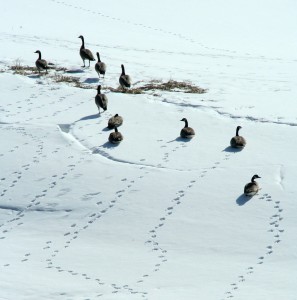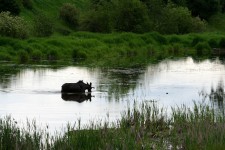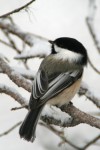Staying warm in winter is crucial for animals to survive. Mammals have thick fur and birds fluff their feathers but their legs often have little to no insulation. Keeping extremities warm can be a struggle for animals. But some animals purposely don’t keep their legs warm to save energy.
The feet of a caribou can be 55 degrees Fahrenheit cooler than their core body temperatures (105 degrees Fahrenheit). A mallard’s webbed feet may only be one degree warmer than the ice it is standing on.
Cold feet may seem counterintuitive to staying warm but cold feet actually help the animal stay warmer. Cold-footed animals have a special arrangement of arteries and veins in their legs that aids heat exchange and is called countercurrent heat exchange.
Remember that arteries leave the heart with oxygen-rich blood and veins return oxygen-depleted blood back to the heart.
When an artery leaves the core of the body into an extremity, in this example a bird’s leg, the blood is as warm as the core. As the blood travels to the end of the leg, which has little insulation, the blood cools down.
In animals without countercurrent heat exchange (such as people), the cold blood returns to the core and has to be warmed within the core, expending significant energy.

When geese can’t keep their feet from freezing, they tuck one or both feet into their feather to warm them up.
However, in animals with countercurrent heat exchange (such as birds) the placement of the vein is extremely close to the artery. Close enough that the venous blood can absorb the heat lost by the cooling arterial blood as it flows to the end of the extremity. Remember that heat is conducted from a warm object to a cold object.
Even near the foot, the cool arterial blood is warmer than the cold venous blood starting to return to the core and still warms the venous blood. As the venous blood moves up the leg, the warmth from the arterial blood becomes greater (because it is closer to the core), thus warming the venous blood even more.
By the time the venous blood enters the core of the body, it is almost as warm as the outgoing arterial blood. Very little energy is needed to warm the venous blood to the core temperature.
Countercurrent heat exchange conserves body heat because the warm arterial blood transfers heat to the incoming venous blood. Thus, very little heat is lost to the environment. Mallards lose only five percent of their body heat through their feet when their feet are 33.8 degrees Fahrenheit.
Cool arterial blood still supplies the oxygen the tissues in the legs need and is warm enough to prevent frostbite.
Many of the animals that spend their time in snow or on ice utilize countercurrent heat exchange to reduce heat loss. Moose and mountain goats are two animals that don’t keep their feet warm.
Aquatic mammals also use countercurrent heat exchange to minimize heat loss. Cold water can drain the warmth of an animal faster than cold air. Turtles and seals use countercurrent heat exchange to supply their flippers with oxygen yet minimize heat loss and beavers use it in their tails.
Even though ducks and geese minimize heat loss by keeping their feet cold, sometimes their feet become too cold. Then they tuck one foot into their feathers to warm it up while they stand on the other foot because sometimes it’s just too cold.





